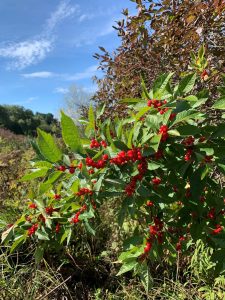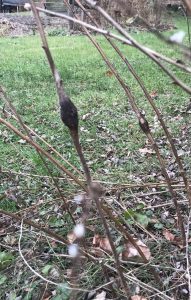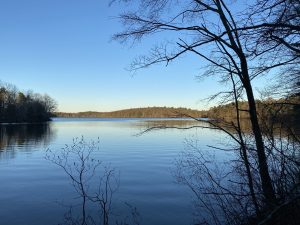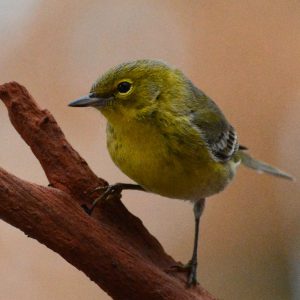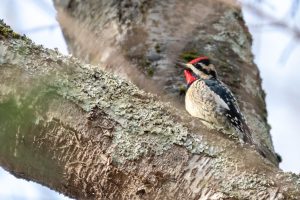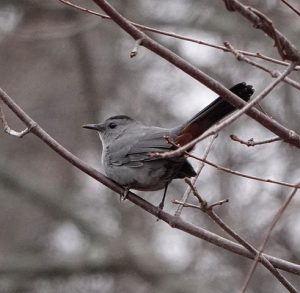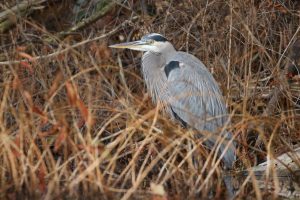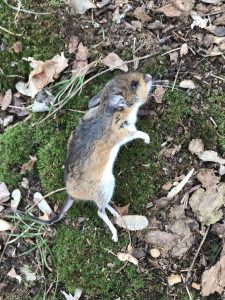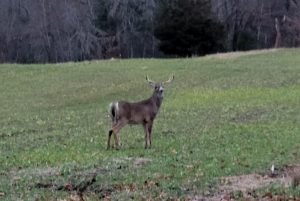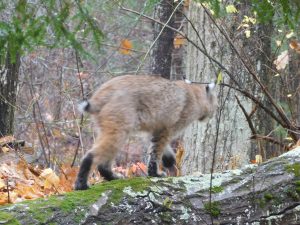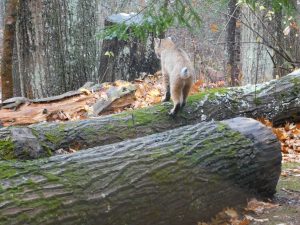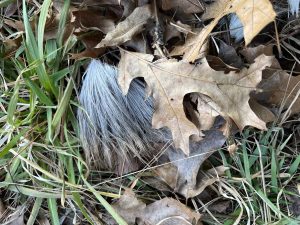Written by Gwyn Loud for the Lincoln Land Conservation Trust. She welcomes your sightings and questions at 781-259-8690 or gwynloud555@gmail.com.
Winter will officially start on Dec. 21, the solstice, and thereafter the lengthening hours of daylight will cheer us, even though the cold of the season lies ahead. The past month has seen only a dusting of snow and a number of unusually mild days. Oaks and beeches still hold some leaves but the branches of other deciduous trees are bare and the landscape is a palette of soft grays and browns, punctuated by dark green conifers and bright green lawns. Tamaracks are unusual, being deciduous conifers, with needles turning yellow in the fall. One place to find them is in the bog next to Beaver Pond. Various berries punctuate the scene with red, including winterberry. It is not the first food choice of birds, perhaps because the fruits are so acidic, but the berries will disappear when food is hard to find as the season progresses.
Winter weeds, as well as providing important seeds for wildlife meals, have a beauty all their own, displaying a great variety of shapes and shades of brown. Some stems of goldenrod show a swollen sphere which is a type of gall. As Mary Holland writes, “Galls are abnormal plant growths that are caused primarily by insects, but also by fungi, mites, nematodes and bacteria. Each gall insect has a specific plant host which produces a distinctive-looking gall. Of the 2,000 gall-producing insects in the United States, 1,500 of them are gall wasps or gall gnats. Of the over 800 different gall-makers on oaks, over 700 are gall wasps.” The gall contains nutrients for the small inhabitant, which grows and then departs without damage to the host plant. A familiar gall called an oak apple is a small round papery sphere which we may find on the ground near oaks, with a tiny hole where the wasp emerged.
Ducks seemed late in arriving on our ponds this year, but recently many turned up on Flint’s Pond, including mallards, buffleheads, hooded mergansers, and twelve common goldeneye – a high number of this species- according to Norman Levey. He also spotted approximately 88 common mergansers, although over the past twenty years he has had as many as 140 in a flock. Other recent bird sightings of note include a winter wren, yellow-bellied sapsucker, fox sparrow, brown creeper, purple finch, and a great-blue heron hunting for food (probably rodents) in the woods. A couple of people have reported a red-breasted nuthatch but this “irruptive” species is not expected to be plentiful this winter. An orange-crowned warbler in the Ricci Fields and a yellow-breasted chat near Valley Pond were unusual discoveries, and a few hermit thrushes, gray catbirds, and a lingering pine warbler have been reported. These species normally head farther south but a few hardy individuals often over-winter. Due to climate change we may see this more often. Belted kingfishers are still here, and will stay as long as the water is open and they can fish.
A couple of people have lamented to me that “no birds are coming to my feeder”. I have no answers, except to suggest the possible frequent presence of hawks (especially Cooper’s), outdoor cats, or the great availability of wild seeds and berries due to lack of snow cover so far. Furthermore, we have all read of the sad decline of songbirds, nearly 3 billion in North America since 1970. The reasons are numerous, but include habitat loss, climate change, decline in insects, and use of pesticides. A citizen science project which those who maintain bird feeders might enjoy is called Project Feeder Watch. Check it out at feederwatch.org. I have been doing it for nineteen years and it helps me pay close attention to who is coming to my feeders and also contributes to nation-wide data on bird populations.
The annual Christmas Bird Count is organized all over the country by the National Audubon Society within a two-week window. The data collected gives valuable information to show change in population numbers over time and the impacts of climate change and other factors. Lincoln is part of the Concord Bird Count and we will be counting on Jan. 2, 2022. Townspeople who would like information about participating either as part of a field team or counting birds at feeders should check the website: https://concordcbc.org, call or text Norman Levey at 781-259-0855, email him at norman.levey@gmail.com, or contact me. Safe COVID protocols will be followed.
As for mammals, once again a bobcat was seen, this time in a backyard on Cedar Rd, not far from Mt. Misery. A couple of people have reported white-tailed bucks and healthy red foxes, and I have listened to a chorus of howling coyotes at night. Looking up into trees, you might see a rounded ball of dry leaves. These are called dreys and are made by gray squirrels as places to shelter in the winter. On a recent walk I came upon a beautiful white-footed mouse. It was dead but showed no sign of external injury and I worry that it was the victim of rodenticide. These poisons do not kill the rodent right away but allow the animal to continue to roam, slowly bleeding to death internally. If a predator, such as a hawk, captures many such poisoned rodents, the predator can die too. Please do not use rodenticides!
In my previous column I wrote about how frogs overwinter but what about turtles? Two of our commonest, painted and snapping turtles, which breathe air with lungs in warm months, go down deep into ponds. They live underwater, lowering their metabolism by as much as 99% so they do not need to eat. They absorb sufficient oxygen from the water through their mouths, skin, and cloaca.
As this is my final wildlife column of 2021 I would like to take the opportunity to thank my “official team” of wildlife observers: Ryan Brown, Stacy Carter, Vin Durso, Marcia Gagney, Michele Grzenda, Nancy Hammond, Sue Klem, Jane Layton, Norman Levey, Kathleen Lomatowski, Ron McAdow, Harold McAleer, Ellen Meadors, Alaric Naiman, Corey Nimmer, Tia Pinney, Nancy Soulette, Pam Sowizral, Rob Todd, and Robin Wilkerson. I am also grateful for the calls and e-mails from other observant townspeople who appreciate the many forms of wildlife around us. Thanks go as well to Miranda Loud for proofreading and to Bryn Gingrich who puts the column on the LLCT website, along with photos.
I wish my readers good health and restorative experiences in the natural world in the new year. Here’s to a better 2022 in every way!
© Gwyn Loud


